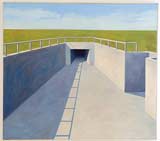Artist wants viewers to think about works’ deeper meanings

A Spiva exhibit with works by a Northwest Missouri University instructor will run through Oct. 29.
Conflict isn’t always a bad thing – at least not for Armin Muhsam, assistant professor of art at Northwest Missouri State University.
A collection of Muhsam’s work is currently on display in the Spiva Art Gallery. The collection is part of five years worth of work examining the relationship between nature and science.
“I have mostly interpreted this relationship in terms of conflict,” Muhsam said in a written artist statement. “By narrowing down this multifaceted dichotomy, I have chosen technology as a manifestation of, as well as a symbol for, science.”
Muhsam began his examination by collecting machine parts and creating impossible mechanical devices. Then he moved his focus to the effects of the machines like the traces, tracks and ruts. Now, he focuses on the changing and changed landscape and specifically the face of nature as altered by human invention.
“His old style focused on machinery and new icons, images based on functionality,” said Dewane Hughes, assistant professor of art. “As it often happens with age, you become more subtle and sophisticated in getting across your message.”
Hughes and Muhsam both attended graduate school at Montana State University and are friends. Muhsam is originally from Germany and has shown his art all over the world.
The exhibit contains 22 pieces that are a mixture of paintings on wooden slats with wooden frames and small 3-D sculptures.
The images are simple and intriguing when the viewer takes a deeper look into Muhsam’s motivation for repeatedly painting geometric shapes compiled to create buildings and structures in landscapes of fields and streams.
Hughes thinks the artist is intentionally being subtle and Muhsam’s works are an indication of where art is headed.
“This show, in a significant way, effectively executes what art should be,” Hughes said. “It transcends the way the viewer looks at the world, and I think it does it effectively.”
Muhsam’s work is influenced physically by artist Francis Picabia and theoretically by Joseph Beuys. Heritage is an important part of Muhsam’s style and the exhibit shows a sense of historic German style emphasizing man’s relationship to his environment.
Hughes said much of Muhsam’s motivation comes from the idea humans are self-centered and don’t like to think about being connected to their environment or affected by it. But Muhsam doesn’t want to just give away his paintings’ meanings immediately. He wants the viewer to think about his work.
“It’s an ultra modern mindset,” Hughes said. “You don’t have to make artwork that wears its meaning on its sleeve.”
The exhibit can be enjoyed as a “pretty painting,” Hughes said, even if the viewer isn’t willing to invest thought into the deeper meaning. He encourages students to give the art a try because it might be good for them.
“We need to step away from the idea of needing to be entertained,” Hughes said. “Sometimes you take a pill because it’s good for you even though you don’t want it. Art is a visual stimulant, but it doesn’t have to pander to the lowest common denominator.”
Your donation will support the student journalists of Missouri Southern State University. Your contribution will allow us to purchase equipment and cover our annual website hosting costs.



























